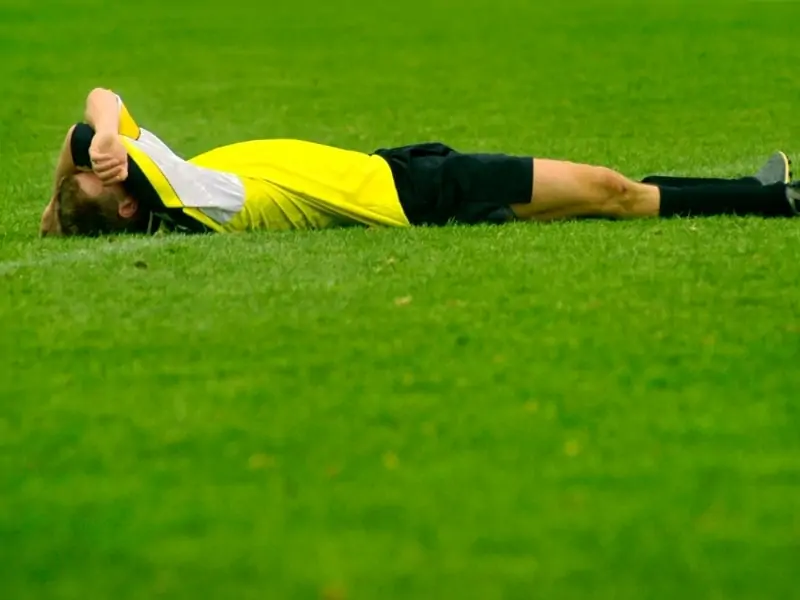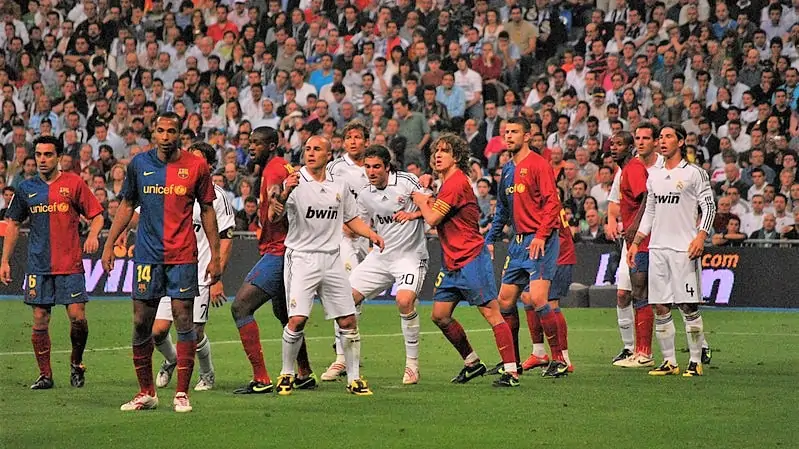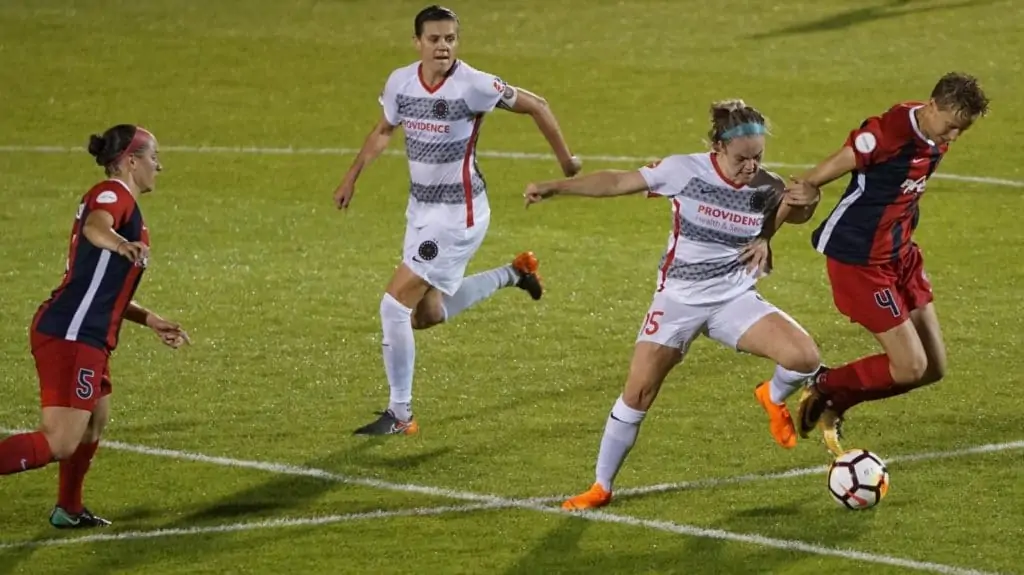Share the post "Flinching Or Scared in Soccer (Gain Confidence and Be More Aggressive)"
In the beginning, many players may hesitate to receive the ball. When it swings their way, they flinch and give the possession away.
For some players, whether skilled or inexperienced, the panic occurs only when the ball moves, and for others, it is a constant worry that plagues them.
Today, we will bring you some tips and tricks on how you can overcome the fear of the ball. The article focuses on the following topics:
- How to stop flinching in soccer
- How to gain confidence in soccer
- How to get more confident in soccer

How to Stop Flinching In Soccer
Here are some noteworthy tips that you can incorporate into your soccer games to avoid flinching.
Practice
It’s entirely normal to be afraid of the ball at first. However, you can overcome your fear of soccer balls. The most effective technique to overcome fear is to have your brain do what it is afraid of.
If you learn, start practicing, and then practice some more, you will eventually be able to train your brain to not be afraid of the soccer ball.
If you’re terrified of the ball flying at you, kick it high into the air and try to keep it under control. If you’re afraid of the ball flying at you from the floor, have a friend pass the ball to you quickly or practice by hitting a wall with the ball and collecting it on the rebound.
It will take time but soon you will be able to gain more confidence. Simply keep practicing and create settings in which you are forced to confront your fears.
Meditation
Meditating will benefit you not just in soccer, but in life as well. It is effective, and most seasoned players use and recommend it.
When you think about it, our feelings guide our behaviors and perceptions of everyday life. Which can be both beneficial and bad. Feelings aren’t the same as reality. Our emotions should not always rule our actions.
You can separate your sentiments and not allow them to be the driving force behind your actions when you meditate.
You’ll learn that being terrified of the ball is just an emotion, but it doesn’t mean you should avoid it when it comes to you. In the end, your actions will not be dictated by your emotions.
Some ways in which you can meditate easily are:
- Close your eyes for a moment.
- Inhale and exhale
- Concentrate on your breathing.
- Remain still for around 10 minutes
You can see how useful this may be in your daily life. You won’t be bothered to eat that white chocolate cookie just because you’re hungry anymore.
When you take a deep breath, you realize you don’t have to act on it, and the temptation fades away. The same principle applies to your game.

Patience is the Key
Teaching yourself not to be terrified of the soccer ball, like anything else, will take some time. This is not going to change overnight. What you should be concentrating on is how much you are improving.
Don’t worry about your fellow players; they’ve already figured it out. Work on your fears regularly and monitor your performance at the end of the day.
Furthermore, learning anything worthwhile takes time. It’s all a natural part of the process. The same may be said for conquering your phobia of soccer balls. Time will pass, and it will take a huge toll. Do not get disappointed if you skip a day or even a week of practice. Simply get back into it.
Let the Ball Hit You
Take those hits, they won’t kill you. It may hurt for a few seconds, but it will pass soon. Put yourself in situations where you’ll have to accept hits to improve your practice.
Having a friend hit a soccer ball to your feet is a great way to practice. Keep a safe distance and don’t try to stop or control the ball.
Allow it to strike you. Make sure that your friend does not hit the ball too hard as it might cause injury.
Think about How Big You Are
If you consider it objectively, you’ll see it’s a little ridiculous. When we contrast sizes, we can see that you are significantly larger, stronger, and bigger than the ball.
The ball weighs around a pound and is packed with air. Yes, when it is struck, it can have a lot of pace, but still, it can’t do much harm to you.
You shouldn’t be afraid of the ball; instead, it should be the other way around.

How to Play More Aggressively in Soccer?
A lot of people are quite interested in how to play more aggressively in soccer and how to face the ball with full confidence. If you also want to play aggressive, here are some techniques:
Learn How to Shoulder Charge
By forming two lines, you can easily learn how to shoulder charge. You are supposed to start shoulder to shoulder.
When shoulder charging, it’s best to start with a light jog. It’s critical that all the players stick together.
The coach can throw a ball for any of the players to retrieve. This trains you and your team members when and how to use the shoulder charge, which improves tackling skills while also making you more aggressive and removes the fear of flinching.
Put Pressure on the Ball
Most of the aggressiveness in the game is down to the nature of the player. There are some incredible soccer players who never become aggressive, but they are fast or extremely good.
However, most defenders have to play aggressively to be good at the game.
Aggression does not always have to mean pushing other players down; it can simply mean putting pressure on the team with the ball.
For that, when the opponent player is approaching, maintain pressure on them. If you get an opportunity to tackle, go ahead and take the ball away.
When your teammate is charging in, try to mark your man. This will put pressure on the opponent team’s player to lose the ball.
Understand your Strengths and Weaknesses
Aggression is a trait that soccer players are equipped with. Some people run like crazy while others are physically active. You’ll be one or the other, particularly at a younger age.
Three effective strategies for dealing with aggression include shoulder charge, shielding, and tackling.
How to Gain Confidence in Soccer?
You can’t become a good soccer player if you lack confidence. If you’re fearful, all your hard work improving your talents and being in shape will go in vain.
When you don’t have confidence, it will be like moving with heavy boots of steel. This will constantly bring your down and slow down your reaction time.
Here are some tips to gain confidence as a player. You can follow them and regain your playing strength and dignity easily.
- The first thing to do is to figure out your problems. There is a wide range of confidence problems. To put it another way, some problems are simpler than others.
- Consider why you lack self-assurance. It could be a specific issue. You might be afraid of losing the ball with your first contact, but you can defend, score, and dribble just fine.
- Concentrate all your efforts on correcting your flaws. On vacation days or after practices, put in the additional time and effort.
- Fixing your flaws can make a tremendous difference in your game. Just resolving one minor issue will boost your self-assurance and productivity.
Enjoy the Game and Be confident
All in all, soccer is indeed a wonderful game to play and players who are truly enthusiastic and passionate about the dynamics of the game will be willing to overcome all their insecurities and fears to achieve the best that they can!
With the tips and tricks provided above, you’ll be able to stop flinching in soccer. You’ll gain confidence and won’t’ hesitate to receive a pass, shoot the ball, or tackle the opposing team’s players.
Once you stop flinching, you will notice a remarkable improvement in your game.
Share the post "Flinching Or Scared in Soccer (Gain Confidence and Be More Aggressive)"
Joel is a seasoned soccer journalist and analyst with many years of experience in the field. Joel specializes in game analysis, player profiles, transfer news, and has a keen eye for the tactical nuances of the game. He played at various levels in the game and coached teams - he is happy to share his insight with you.



